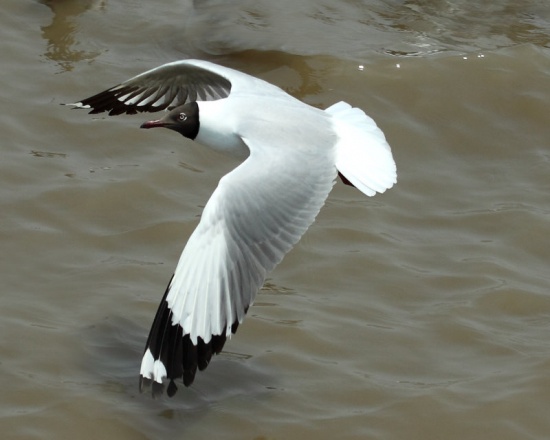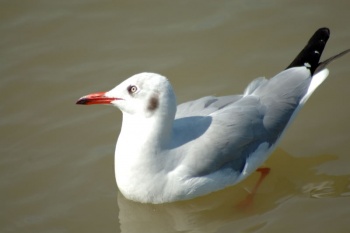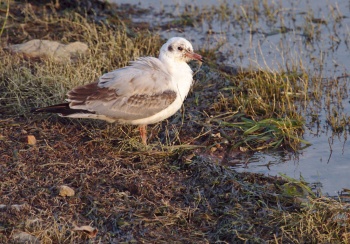- Chroicocephalus brunnicephalus
Larus brunnicephalus
Identification
41–45 cm (16-17¾ in). A two-year gull, similar to Black-headed Gull and often best told apart in flight:
Adult
- Grey upperwing and broad white primary base, creating white half-moon against black wing-tip with prominent white mirrors
- Red bill and legs, very dark when breeding
- White eye, white eyelids
- Dark brown hood, often paler towards face. In winter white head with dark-brown spots in front, above and behind the eye
- White tail
Juvenile
- Upperwing similar to Black-headed Gull but with solid black wing-tips and white restricted to streaks on inner primaries and primary coverts dark-streaked
First winter (August to January)
- Bill darker orange red than Black-headed Gull
- Wing-coverts with slightly broader pale edges
- Wing similar to juvenile
First summer (January to August)
- Almost looking like adult in winter (unlike other two-year gulls)
- More uniform black wing-tips than adults, white half-moon less distinctive
Similar species
Similar to Black-headed Gull but note different wing patterns and white eye in adults. For juveniles and first-winter birds see text above.
Distribution
Breeds in the mountains of south-central Asia between 3000 and 4500m. Winters on the coasts of India, Sri Lanka and southeast Asia, sparingly west to the Arabian Peninsula.
Common to abundant in its range.
Taxonomy
This is a monotypic species[1] which is sometimes placed in the genus Larus[2].
Habitat
Mountain marshes, reedbeds, and islands in lakes during breeding season, at coasts or rivers during winter.
Behaviour
Diet
They have a very wide ranging diet; live prey consisting of fish, shrimps, insects, slugs, worms and rodents. They also eat offal and visit sewage farms. Plant material such as shoots and potatoes are also included.
Breeding
It nests colonially on the ground, with breeding season starting in May. Starts laying eggs even when breeding lakes are still frozen.
Colonies usually with around 50 pairs but also bigger ones with several thousand pairs (Tibet) known. Breeds often near to Common Terns.
The nests are close together and are made of masses of plant stems. Lays 3 eggs.
One record of hybridisation with Slender-billed Gull.
References
- Clements, J. F., T. S. Schulenberg, M. J. Iliff, D. Roberson, T. A. Fredericks, B. L. Sullivan, and C. L. Wood. 2017. The eBird/Clements checklist of birds of the world: v2017, with updates to August 2017. Downloaded from http://www.birds.cornell.edu/clementschecklist/download/
- Avibase
- Handbook of the Birds of the World Alive (retrieved December 2017)
- Wikipedia
- IUNC Red List datasheet
Recommended Citation
- BirdForum Opus contributors. (2025) Brown-headed Gull. In: BirdForum, the forum for wild birds and birding. Retrieved 9 May 2025 from https://www.birdforum.net/opus/Brown-headed_Gull
External Links
GSearch checked for 2020 platform.1







